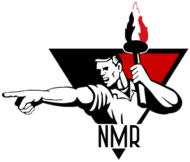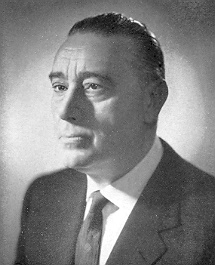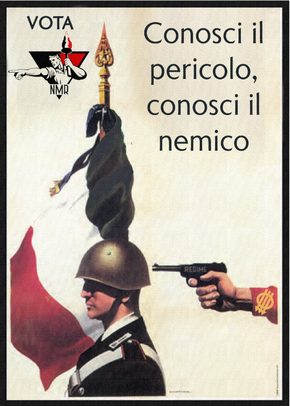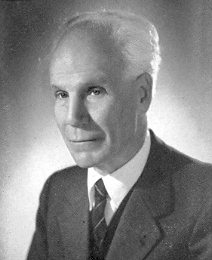User:Tranvea/Sandbox 7
New Republican Movement Nuovo Movimento Repubblicano | |
|---|---|
 | |
| Abbreviation | NMR |
| Leader | Giorgio Garafola Giosuè Fioriti Goran Jurić |
| Founded | March 15, 1947 |
| Dissolved | October 9, 1986 |
| Merger of | National Solarian Party Etrurian Patriotic Worker's Party |
| Succeeded by | National Democratic Party Social Party-Caccio National League for Etruria |
| Headquarters | Palazzo Maschera, Solaria |
| Newspaper | La Fiamma (The Flame) |
| Youth wing | Nuova Gioventù Repubblicana ("New Republican Youth") |
| Paramilitary | Custodes (alleged) |
| Membership | 405,302 (1986) 849,500 (peak, 1958) |
| Ideology | Etrurian nationalism Neo-national solarianism Neo-functionalism National conservatism |
| Political position | Right-wing to Far-right |
| Religion | Solarian Catholicism |
| Colours | black |
| Anthem | Bandiera Tricolore "Tricoloured Flag" |
The New Republican Movement (Vespasian: Nuovo Movimento Repubblicano), also known by the abbreviation NMR, was a far-right Etrurian nationalist party that existed from 1947 to 1986. It officially declared itself a "patriotic national conservative party" but espoused policies and ideologies closer to nationalism, Neo-Functionalism and Neo-National Solarianism. The NMR played a pivotal role during the Etrurian Third Republic and its support for the 1960 Etrurian coup d’état led to many of its promiment members being given positions in the subsequent military junta. It is widely accredited for the rehabilitation of the Etrurian far-right in the post-Solarian War period and the failure of Etruria coming to terms with its far-right past and historic war crimes.
Established in 1947 through the merge of the National Solarian Party and Etrurian Patriotic Worker's Party; two successor parties to the Revolutionary Legion, that ruled the Greater Solarian Republic (1938-1946). The establishment followed other parties who formed the same year in anticipation of the dissolution of the Community of Nations-led provisional government, and elections in late 1947. The establishment of the NMR caused controversy, owing to thread connecting the party with the Revolutionary Legion, despite this, the party was permitted by the provisional government in anticipation and expectation it would be exiled to the political fringe due to the legacy of the GSR and the Solarian War.
In the 1947 Etrurian general election, the NMR under leader Giorgio Garafola won 19 seats, coming fifth in the vote, by advocating mostly a more statist approach to reconstruction and combatting the rise of far-left politics. Between 1948 and 1950, the NMR under Garafola restrained from following the immediate culture of opportunism and vicious inter-party fighting, regularly denouncing the chaotic legislature as “condemning Etrurian recovery.” The policy of the NMR “acting responsibly and respectably” in comparison to the other parties, greatly aided the party in securing soaring popularity. The endemic corruption of the Third Republic coupled with the crippling instability and weakness of successive governments led to the NMR rising to be one of the most powerful and influential entities in Etrurian politics by 1953.
In 1954, the NMR became the second largest party in that year’s election, winning 36 seats. In one of the most pivotal moments of the Third Republic era, the NMR, in exchange for supplying votes for the year’s budget, secured from President Ferdinando Grillo, the dissolution of the National Tribunal for Historic War Crimes and Incidents, a body established in 1946 to prosecute mid and low-level GSR officials for crimes against humanity. In 1955, the entered into coalition with parties aligned with Grillo and securing the revision of history textbooks, whitewashing the Solarian War, passing a law criminalising accusation of crimes against humanity made by Etrurian citizens and lifted the ban on GSR-era symbols and images.
In late 1956, they abandoned the Grillo government, orchestrating its collapse and his removal from office by no-confidence vote due to his inability to confront the rising threat of far-left separatist movements in Carinthia and Novalia. Garafola led the NMR in becoming outspoken hawks on the Western Emergency and by 1958 began secretly advocating military rule. The pro-junta approach of Garafola secured the NMR’s leadership positions of power within the military government (1960-1984). However, their allegiance and participation in the junta would lead to its rapid decline and eventual collapse following the restoration of democracy in 1984. In the elections held that year, the NMR failed to win a single seat. The same year, it fractured into the National Democratic Party, Social Party-Caccio, National League for Etruria.
History
Formation
In wake of the collapse of the Greater Solarian Republic in 1946 and the ruling Revolutionary Legion, many of its mid-level officials went into hiding, just as the highest-ranking members who survived the collapse, were arrested for war crimes by the Community of Nations. The near exclusive focus of the CN Coalition on apprehending high ranking officials, essentially preserved the Revolutionary Legion through its surviving members, many of whom established splinter parties in 1947.
These parties became rallying points for former Revolutionary Legionnaires, war veterans and sympathetic urban and rural workers. In an effort to avoid undue attention from the CN-Provisional government, these parties were outwardly national conservative or Sotirian Democratic. The two main parties to emerge in 1947 as viable entities on the far-right were the National Solarian Party and the Etrurian Patriotic Worker’s Party, led by Viktor Buzolic and Giorgio Garafola respectively. The establishment of the United Socialist Worker’s Party in February 1947, as a umbrella party for the various hard-left and far-left parties in Etruria’s states, so deeply disturbed Buzolic and Garafola they overcame historical and personal animosity to establish the New Republican Movement on 17 March 1947 during a joint congress of both their respective parties.
The formation of a singular party though publicly centre-right, proved to be a lightning rod for former GSR supporters. Within a month, its membership exploded from 3,506 to over 100,000. In preparation for the 1947 elections, the NMR leadership formulated a strategy known as “Imitazione” (Imitation), which would see the NMR run in the year’s elections on a moderate platform, with focuses being on “equal and fair reconstruction, traditional values being restored and national unification from the anger and divisions caused by the GSR’s collapse.” Notably, both Buzolic and Garafola agreed to not put forward a presidential candidate, opting to focus on securing a foothold in the Senate.
1947 Election
1948-1954
1954 Election
1954-1960
Grillo Coalition
Role within the Military Junta
Decline
Collapse
Organisation
Links to the Custodes
Ideology
Throughout its existence, the NMR proclaimed itself to be a national conservative party and rejected accusations it was far-right or that it endorsed Neo-Functionalism, Neo-National Solarianism or nationalism of any kind. It purposefully maintained vague election manifestos, opting for ill defined themes centred around traditional social and family values, law and order, anti-corruption, patriotism and harsh views toward select minorities (particularly Miruvians).
In every election (1948 and 1954 federally), it advocated a strong federal government and a return to the parliamentary system. It was the harshest critic of the 1948 constitution, regularly decrying it as a “creation of the foreign victors”, and depicting the political chaos caused by its clauses, as the intention of the CN, which intended to use the 1948 constitution as another post-war punishment on Etruria. As part of its advocating of traditional social values, it promoted censorship and strict laws on music, theatre and the emerging television medium. It rejected certain civil liberties, including the abolition of capital punishment, corporal punishment and criticised the freedom of the press as a tool for “socialist extremists to spread lies.” It advocated the banning and prosecution of far-left politicians, activists and hard-line trade union leaders, whom the NMR claimed constituted an existential threat to the Etrurian nation. As the chaos and instability of the Third Republic became manifest further into the 1950s, the party turned toward more populist anti-establishment rhetoric and policies, openly advocated by 1956, for a new constitution outright.
As the Western Emergency began in the mid-1950s, the NMR became the harshest force in the Senate in relation to its daily demands for military deployments and internment. The NMR blamed the 1948 constitution and federalism for the crisis and violence, going as far in 1957 to also begin advocating the abolition of the federal system. The NMR's criticism of federalism would become a staple element of the Etrurian far-right even after the restoration of democracy in 1984. The NMR also promoted the use of Vespasian in all official business across the country, while still protecting Novalian and Carinthian at the state level – in turn rejecting the natural tri-lingualism of Etrurian political discourse. By the late 1950s, so fierce was the NMR’s condemnation of the separatist movements that it openly called for emergency laws permitting the return of torture, detention without trial and some members began to advocate the mass expulsion of the entire Miruvian population from Etruria. The party also became a source for conspiracy theories, blaming the entire emergency on the Miruvian population, who they claimed were taking orders from the Amathian Equalist Republic and Kirenia.
While it rejected claims of supporting Functionalism or National Solarianism many of figures within the party advocated elements of both ideologies. Integral to this was the positive or at least partially positive view of the Greater Solarian Republic and the Revolutionary Legion. This came because of many founding members of the party being former members or officials of the RL, notably, Giorgio Garafola served as the District-Leader of the Revolutionary Legion in Etrurian occupied-Piraea. The party also viewed the Solarian War as a defensive war and propagated lies and misconceptions of the war throughout its existence and rejected claims of war crimes, arguing such accusations were further attempts to punish defeated Etruria. This further fed into the party's veneration of Etruria's war dead and the near constant praise for Etruria’s war effort during the Solarian War. It promoted a policy of “respectful reflection” in which it accepted the need to discuss the GSR’s policies that led to widespread devastation and economic collapse in wake of its defeat, but in practice meant focusing on its successes, policies and key figures. It believed that the display of GSR symbols and imagery was part of reflection and saw the ban on such as incompatible with Etrurian patriotism.
Foreign policy
During its first few years, the NMR’s position on foreign policy was erratic and poorly defined. Several prominent members advocated rapprochement with Eastern Euclea, others promoted a Solarian-Centric policy (focusing on Gaullica, XX, Montecara and Emessa) and others who advocated neutrality and limited international engagement.
Following the 1954 general election and the dominant position of the Garafola faction, the party’s foreign policy was defined more succinctly. The party advocated for membership of the burgeoning Euclean Community and reintegration into Euclea’s order. For a far-right political party in 1950s Euclea, the NMR notably included several key figures who promoted a “union of patriotic and sovereign Euclean nations.” Garafola himself claimed this would be the best protection against “socialism and radicalism.” One reason the NMR abandoned its far-right partners in endorsing the EC was the success of the bloc in rebuilding nations devastated by the Solarian War and the Great War, both of which, Etruria was struggling to do so after two decades.
One prominent faction that maintained itself throughout the party’s life was that advocating a Solarian-centric foreign policy. This faction, led by Arcangelo Adriano Odierno did not necessarily oppose Etrurian membership of the EC, but wished for a regional “focus and new system built around the Solarian World.” The Odierno faction reportedly supported the Gaullo-Etrurian union, though the rest of the party was fiercely opposed. The one thread that united NMR internal factions on foreign policy was the vociferous opposition to socialism and the socialist states of Euclea, notably the Amathian Equalist Republic and Kirenia. Numerous NMR figures would regularly call for an alliance between Eastern Euclea and Soravia against the socialist bloc, leading to strong links between the NMR and Soravian Nationalist and Revivalist Party.
Legacy
Following its collapse in 1984, much of the NMR’s legacy was rooted in its direct involvement and support of the military dictatorship, rather than any specific issue or achievement. As the historical study in the 1990s progressed began to focus on the Etrurian Third Republic, there was a wave of studies into the lasting influence of the NMR.
In 1994, the historian Franco Gugliuzza wrote in his book covering the party, “while so much of the Third Republic can be recognised as a failure of statecraft, the New Republican Movement was the only success story, insofar that it achieved its aims – it halted reconciliation with the horrors of the Greater Solarian Republic, distorted history to protect the GSR and rehabilitated almost certainly guilty war criminals.” The same year, Ferdinando Franceschi, who served as Deputy President under Vincenzo Biava wrote, “the NMR, a most vile party that did more than any entity to facilitate the totalitarian dictatorship of recent times, also did more than any other entity to ensure Etruria was denied the right to de-functionalise, Gaullica took the right path, ours was barricaded shut by enemies of democracy.” The NMR's success in shutting down the National Tribunal for Historic War Crimes and Incidents and lifting the ban on GSR symbols and images played significant roles in the survival of the Etrurian far-right for decades. It's greatest success according to historians, was its brief tenure in running the Federal Ministry of Education, in which it instigated a nation-wide revision of textbooks and teaching guides, whitewashing topics around the Solarian War. The revisionist approach to education was continued under the military government (1960-1984), which was also done in state sanctioned media.
The extent the party succeeded in rehabilitating the far-right, barely a decade after it led Etruria into the death and destruction of the Solarian War was further debated in the 2000s, during which time numerous smaller parties inspired by the NMR grew in popularity. Gugliuzza again wrote a second book on the NMR saying, “as time progresses, we further understand the lasting impact the party had on this country. Where in Gaullica is disgraceful to deny crimes, in Etruria, its disgraceful to suggest them. Where in Gaullica they see their history clearly and with the lasting intention of avoidance, in Etruria, we look to our darkest chapter with reverence and at times, a mournful longing. The NMR is to blame for this, it kept the stain of the GSR where it should not be, in our hearts.”
To right-wing Etrurians, the NMR is viewed more positively. Francesco Carcaterra, when serving as a senior history lecturer at the University of San Michele wrote in 2001, “many can condemn the NMR for its rehabilitation of certain individuals, but many can also thank it for keeping so many weak-willed and often cowardly governments’ feet to the fire. If it were not for the NMR, perhaps the Western Emergency would have been shorter and more successful for the separatist.”
The party’s ideology and electoral strategies were emulated by its successor parties and future far-right parties, including the Tribune Movement. While some far-right parties sought to distance themselves from their own inspiration, many leaders of the Etrurian right would praise the NMR. Gianfranco Galizia in 2018, called it an inspiration for all “patriotic parties in Euclea.”


